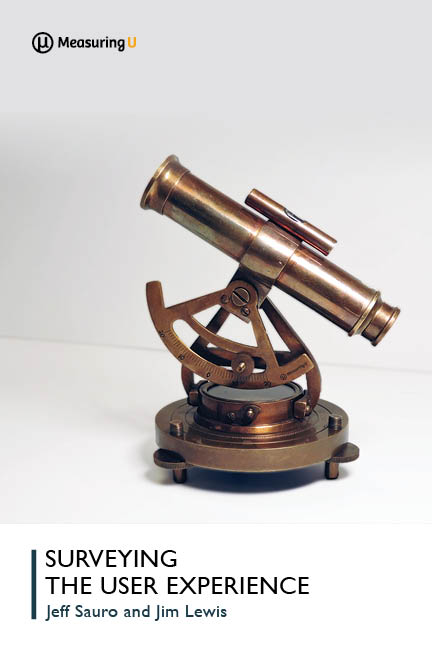
Purchase Hard Copy on Amazon | Download Electronic Copy
This is a practical book about how to plan, design and analyze surveys in the user experience (UX) and customer experience (CX) fields.
You might wonder—do we really need another book on surveys?
There are a lot of books on survey design and analysis. While writing this introduction, a search on Amazon for “survey design and analysis” returned 360 results. So, what makes our book different? This book is for UX researchers, CX professionals, designers, product owners, marketers, and anyone else who has a vested interest in collecting data through surveys. In a nutshell:
- Survey Best Practices Are Constantly Evolving: Surveys may be an old research method (around for millennia depending on the definition), but the methods and practices are constantly evolving in response to changing styles, new technologies, published opinions, and findings from experiments.
- Surveys Remain a Popular Method: Despite criticisms of surveys being a “lazy” research method by some UX research mavens (an unwarranted and overly general criticism, in our opinion), surveys are widely used in UX and CX research (just behind user research and usability testing in popularity according to the User Experience Professionals Association’s 2022 survey of its membership).
- Surveys for Politics are Different from Surveys about Products and Services: We focus on surveys for UX and CX research. This matters because much of the literature on survey research and design focuses on politics and social issues, which appear to be more prone to response biases such as acquiescence and social desirability.
- We’ve Compiled the Largest Collection of Research on Response Options: Much of our book provides critical literature reviews of research that is often cited to support survey design practices (with a focus on the impact of variations on response options) and data from our own experiments to investigate variations in survey design methods in the context of UX and CX research. In writing this book, we conducted dozens of experiments, using data from over 10,000 respondents to provide up-to-date recommendations (and debunk some lingering misconceptions).
In this book, we use practical examples gleaned through years of experience developing, conducting (and taking) surveys for both Fortune 500 companies and small startups. We use examples of surveys that the team at MeasuringU has performed to give you constructive information for better surveys.
Like most professionals, you have probably taken several surveys and may have created some of your own. Whether you are new to surveys in applied research or you have some experience, the introductory chapters provide a thorough background and overview of developing better survey questions. We’ve organized the chapters into four sections:
- Part 1: Planning the Survey (Chapters 1–4): Guidance on the common “how much,” “how long,” and “how do we” questions, with practical advice on making the most of your survey.
- Part 2: Writing Survey Questions (Chapters 5–9): Methods for choosing and writing survey questions guided by an understanding of the anatomy of survey questions and the effects of human memory and cognition.
- Part 3: Survey Response Options (Chapters 10–16): Data-driven guidance on leading practice in survey item formats, starting with a taxonomy of response options and literature reviews and continuing with original experimentation on the effects of the number of scale points, labeling, item tone, primacy bias, acquiescence bias, cultural effects, and numerous presentation effects.
- Part 4: Data Collection & Analysis (Chapters 17–22): Several step-by-step guides on gathering raw survey data, graphing survey data, and using leading practices for statistical analysis and reporting.
The book ends with two appendices:
- Appendix A (Statistical Considerations): A review of statistical confidence and the meaning of statistical significance.
- Appendix B (Commonly Used Survey Type sand Questions): Wording, response formats, and additional reading for questionnaires and items commonly used in UX and CX survey research.
Our goal with this book is to help fill in the gaps in conducting and analyzing surveys, differentiating conventions that aren’t backed by data from practices where research shows clear pros and cons of response options or techniques. We have also developed a companion online course that covers the bulk of the material in this book, available online at MeasuringUniversity.com.
Table of Contents
PART 1: PLANNING THE SURVEY
CHAPTER 1: Introduction to Survey Design
CHAPTER 2: Biases & Errors in Survey Design
CHAPTER 3: Defining & Finding Participants
CHAPTER 4: Sample Strategies
PART 2: WRITING SURVEY QUESTIONS
CHAPTER 5: Survey Question Anatomy and Types
CHAPTER 6: How to Write a Survey Question
CHAPTER 7: Why People Misinterpret Survey Questions
CHAPTER 8: How to Make Survey Questions Clearer
CHAPTER 9: Why People Forget & How to Improve Recall
PART 3: SURVEY RESPONSES
CHAPTER 10: Selecting the Right Response Options
CHAPTER 11: The Number of Points in a Rating Scale
CHAPTER 12: Labeling Points
CHAPTER 13: Item Tone & Left-Side Bias
CHAPTER 14: Agreement, End Points, and Cultural Differences
CHAPTER 15: Presentation Effects on Rating Scales
CHAPTER 16: Response Option Visual Formats
Part 4: DATA COLLECTION & ANALYSIS
CHAPTER 17: Sample Size Calculations
CHAPTER 18: Planning and Logistics
CHAPTER 19: Preparing for Survey Analysis
CHAPTER 20: Single-Item (Univariate) Analysis
CHAPTER 21: Two-Item (Bivariate) and Three+ Item Analysis
CHAPTER 22: Displaying Survey Results
APPENDIX A: Statistical Considerations
APPENDIX B: Commonly Used Survey Types and Questions
REFERENCES
INDEX


